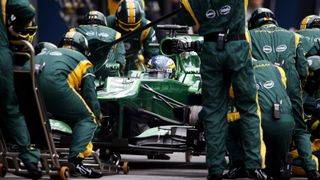How do you turn 20GB of data into a faster F1 lap time?
How Dell helps the Caterham F1 team to do more

How do you improve performance in Formula 1? By getting the right team in place and the right systems. Dell drives performance for Caterham F1 by creating a mobile office for 60 people at the 20 F1 races each year.
When the Team was accepted into Formula 1, they had just five months to build a team from scratch. At that time, the team had no cars, no drivers and certainly nowhere near the type of technology it takes to build and maintain a 21st century Formula 1 racing team.
Dell, together with Intel, raced to the task, and designed and deployed a complete computing environment for Caterham F1's state-of-the-art Oxfordshire HQ in less than 22 weeks.
Dell developed powerful systems to take the team from the desktop to the driver's seat, capable of turning 20GB of raceday data into distance with the help of supercomputers capable of performing billions of calculations in the span of a few hours. Dell, in association with TechRadar Pro, can help you understand how to manage your own infrastructure and be more productive – check out www.techradar.com/pro/dell
"We realised that Dell understood everything from the technology needed to design an F1 car, to our requirement for trackside mobility and storage that could withstand extreme temperatures and vibrations," says Bill Peters, Head of IT for the Caterham F1 Team.
The work included creating a high performance computing (HPC) cluster to simulate and test an exact replica of the car they'd later take to the track, enabling them to pinpoint and solve potential efficiency problems ahead of race day.
The HPC solution for computational fluid dynamics (CFD) is driving forward car development for the team – it can perform 163,398 calculations per second and can accurately simulate a wind tunnel in a virtual space.
Get daily insight, inspiration and deals in your inbox
Get the hottest deals available in your inbox plus news, reviews, opinion, analysis and more from the TechRadar team.
The system consists of 186 Dell PowerEdge M610 blade servers with Intel Xeon processors and PowerVault MD3200 and MD1200 storage arrays.
Because of the significant amount of data traffic, Dell PowerConnect series switches are also used. Caterham F1 also uses Alienware Area-51 desktops.
Gearing up for race day
Ensuring the infrastructure is resilient on race day is crucial. The Caterham F1 Team trackside infrastructure fits into just half a rack, whereas infrastructures of other teams fill an entire rack. This significantly lowers shipping costs.
Peters says: "I had a high-level idea of what we needed, but Dell designed and deployed everything to meet our challenges. When an F1 engine starts, the ground shakes, so we have solid-state drives in our EqualLogic storage, plus Dell demonstrated that the PowerEdge servers and storage had been tested in extreme heat – more than 40 degrees Celsius, just as we experience [when we race] in Abu Dhabi."
"At the track, a strong network is essential," says Peters. "We pull huge amounts of data from the cars because they're racing every lap, so high performance and stability are paramount." The team uses Dell Latitude E6500 and E4300 laptops with Intel Core 2 Duo processors and Dell Precision M6600 and M4600 mobile workstations with Intel Core processors to process the data streaming from cars on the track."
The team also benefits from on-site Dell support should there be an issue – because of Dell's support network, Dell ProSupport, there is always support close by, 24 hours a day, seven days a week.
Dan (Twitter, Google+) is TechRadar's Former Deputy Editor and is now in charge at our sister site T3.com. Covering all things computing, internet and mobile he's a seasoned regular at major tech shows such as CES, IFA and Mobile World Congress. Dan has also been a tech expert for many outlets including BBC Radio 4, 5Live and the World Service, The Sun and ITV News.
Most Popular

